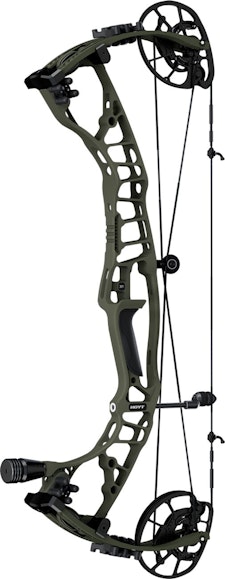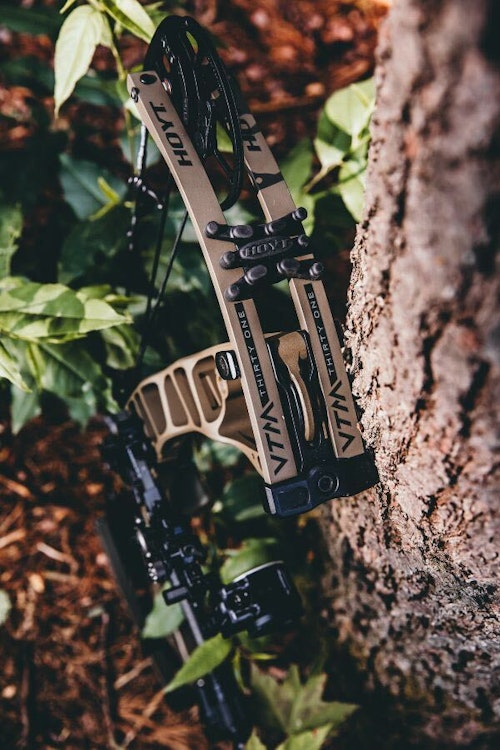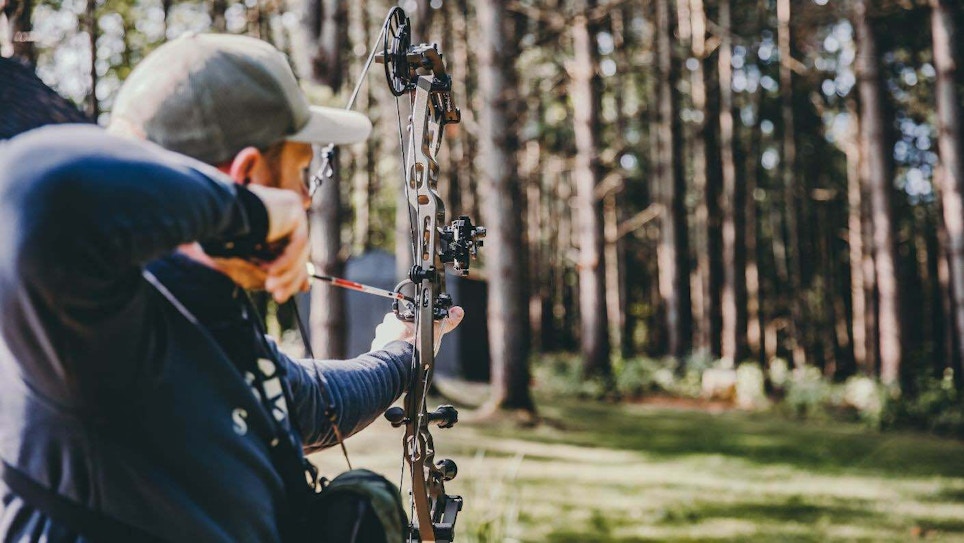
Hoyt’s VTM 31, despite being a short hunting bow, has tons of stability. The author loves how the bow aims, and he didn’t even utilize the In-Line System due to the accessories he had available.
A manufacturer’s longevity in any industry says three things. First, the brand is innovating and staying on top of the times. Second and third, the brand is creating reliable products and standing behind them.
Of course, buying from such a manufacturer instills great peace of mind. I can think of several such brands that have storied existences in the archery industry, but Hoyt is undeniably the first that comes to my mind. After all, it’s one of the oldest in the business. Hoyt has existed — and been a definitive industry leader — since 1931 when Earl Hoyt Sr. embarked on his dream of creating “the best bowhunting and target archery equipment possible,” as the company’s website states.
Hoyt’s drive to innovate has been undeniable even from its inception, and when you compare today’s Hoyt compound bows with everything else out there, it’s obvious that Hoyt is still in its own distinct lane. Hoyt bows don’t resemble any others, and that goes for the new VTM 31. The VTM is the third generation of the original Ventum, and it has a lot to talk about.
Test Bow Specs
- Axle-to-Axle Length: 30 5/8 inches
- Brace Height: 6 inches
- Draw Length: 28 inches
- Draw Weight: 70.5 pounds
- Let-off: 85%
- Bow-only Weight: 4.6 pounds
- Accessorized Total Weight: 6.6 pounds (no quiver)
- Velocity: 281 fps (with 468-grain Easton 6.5mm Acu-Carbon 340 arrow); 284 (with 456-grain CX Maxima Triad 350 arrow); 288 (with 441-grain Victory VAP SS 350 arrow)
- Kinetic Energy: 81.97 foot-pounds (Easton); 81.59 foot-pounds (CX); 81.14 foot-pounds (Victory)
- Test-Bow Finish: Wilderness
- MSRP: $1,349 (starting price)
- Contact: www.hoyt.com
First Impressions
Hoyt grips have been acclaimed as some of the industry’s most comfortable for years. It landed on a real winner way back in 2006 on the VTec. Subtle tweaks have been made along the way, leading to the current VitalPoint Grip, which was first featured on the Ventum Pro last year and is back on the VTM. It’s more squared off than previous designs, enhancing comfort and reducing torque, but the riser shelf and the grip’s throat have a familiar fit and feel that’s been around for years.
I already mentioned that Hoyts don’t resemble other bows. That mostly has to do with the TEC Riser. Sure, it has changed a lot over the years, but it has been a Hoyt staple for more than 2 decades strong. Its “bridge” design strengthens the riser, but it also directs vibrations away from the archer’s hand during the shot.
While I loved that my initial glance was met with some familiar Hoyt attributes, I dug a little deeper to learn what the VTM does better than the Ventum Pro.
In With the New
Spec-wise, the biggest difference between last year’s Ventum Pro and the new VTM is axle-to-axle length. The Ventum Pro was offered in 30 and 33 sub-models, and the VTM is offered in 31 and 34 sub-models. It isn’t a big deal, but the extra inch can only be a good thing in stability terms. Whether you crave a short and stable compound or slightly longer and ultra-stable one, there’s a new VTM for you.
The biggest improvement is what you don’t see. At the shot, expect nothing but silence and smoothness. Hoyt’s engineers have reworked the TEC riser design and length, and that combined with the new HoleShot V2 string silencers yields a 31 percent decrease in shot noise compared to the Ventum Pro — an incredible attribute when bowhunting jumpy critters.
The final addition benefits archers using drop-away rests. The new Drop Cord Slot integrated into the TEC part of the riser lets the drop-away cord pass through the riser to minimize riser contact. It’s also proof that Hoyt ignores no details.
One Well-Oiled Machine
Besides the TEC Riser and VitalPoint Grip I mentioned earlier, Hoyt has woven some other tried-and-true technologies in and out of the VTM 31. At the pinnacle is the In-Line System. While I didn’t outfit the VTM with In-Line accessories, the benefits of doing so are undeniable.
The In-Line Picatinny sight mount pairs the sight directly to the riser, and compatible sights have no conventional sight-mounting bracket, which reduces sight weight and size. Plus, it is mounted to the lateral center of the riser, which improves balance. The In-Line Integrate rest mount also pairs directly with the riser and positions the accessory weight at the riser’s center.
Utilizing the In-Line sight and rest mounts makes the Superlite Quiver, also part of the In-Line System, fully compatible. It mounts unbelievably close to the riser. When accessorized using the entire In-Line System, the VTM redefines balance that I personally believe only one other competitor has matched. Further, the company says that In-Line accessorizing yields an additional 11 percent sound reduction and a 59 percent reduction in residual vibrations.
The VTM includes the 2-inch In-Line Short Stop stabilizer. The mounting location is positioned lower and farther forward, which decreases the need for a long stabilizer for most bowhunters, although a second stabilizer can be added just beneath the grip based on shooter preference.
On the Range
“If it ain’t broke, don’t fix it” is a common phrase, and that’s why Hoyt brought back the HBX Pro Cams and the Zero Torque Cable Guard this year. The 70.5 pounds of draw weight on the test bow glide so smoothly that it’s almost unbelievable. Hoyt has had some cam systems along the way that transitioned very abruptly into the valley, but the HBX Pro’s transition is buttery-smooth with a nice solid wall. And because Hoyt integrates a rubber insert into the draw stops, hitting full draw is virtually silent.
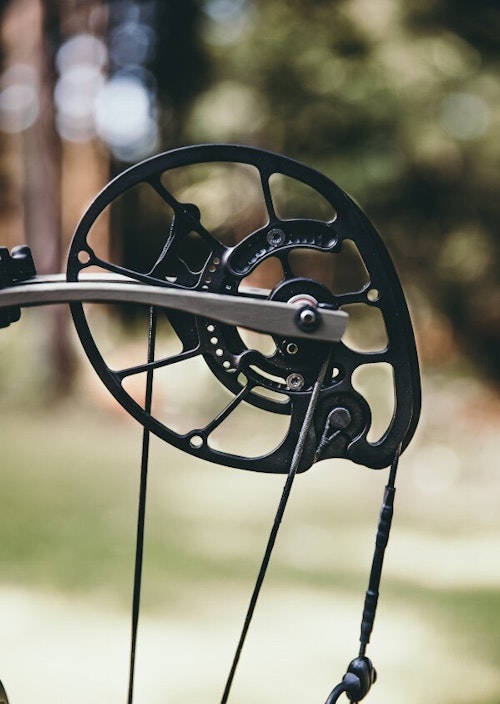
Like last year, two different module sizes govern draw length on the HBX Pro Cams and optimize performance in every draw-length setting. Another nice point is that the draw stops have two settings, allowing the shooter to select 80 or 85 percent let-off. The cams are also very robust, the kind you’d have faith in when you head for the wildest bowhunting destinations.
Besides smoothness, the VTM acquires targets with ease and holds rock-solid at any distance. It’s also extremely accurate. I found my groove immediately with this short hunting bow. In 20 minutes, I had my pins set out to 50 yards. I didn’t shoot many groups to avoid breaking arrow nocks. Instead, I did a lot of hunting-realistic one-shot drills from various yardages, and the VTM 31 zings them in there with ease.
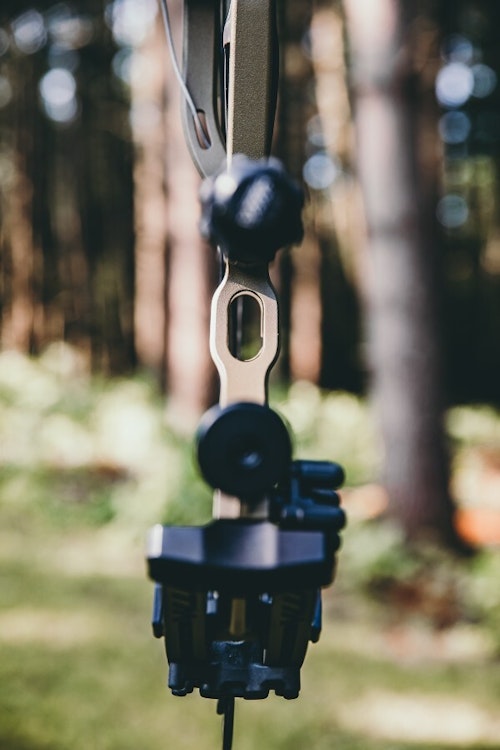
Final Thoughts
As with the Ventum Pro, the VTM’s riser features a tunnel just below the grip and also above the sight-mounting location. This strengthens the riser and averts flexing as the bow is drawn and shot, which makes tuning much easier. Just like the HBX Cams, the VTM’s riser exudes rigidity. It just feels tough.
Besides the HoleShot V2, the VTM includes Limb Shox. And, the TEC Riser is rigged with a dampener near each limb pocket to address vibrations as they transfer from the limbs to the riser.
Finishes and colors are a big deal to many bowhunters, and Hoyt offers the gamut. There are 13 different durable camo and solid hunting finishes, including the all-new Bourbon solid, which is extremely popular. I find the dark-green Wilderness finish on my test bow extremely pleasing to the eye.
For bowhunters who value weight savings, Hoyt brought back the Carbon RX-7 for 2023, which has specs similar to the VTM 31, but weighs about a half-pound less. For the archer who craves maximum stability in a hunting bow, check out the VTM 34, which sacrifices a small amount of velocity for a longer riser and an extra quarter-inch of brace height.
Company longevity is important to me and most folks when purchasing high-dollar items. Whichever Hoyt model you test drive and perhaps eventually buy, you’ll be confident in the company’s storied dependability and commitment to quality and innovation. And that confidence will serve you well as you step up to the firing line or onto your treestand platform.
Additional Notes
The Hoyt VTM 31 was set up using a Last Chance Archery EZ Green Bow Press and EZ Green Bow Vise, and draw weight was calculated using Last Chance Archery’s Digital Bow Scale. A Caldwell Ballistic Precision Chronograph measured the arrow velocities. Other products used were Easton’s Nock and D-Loop Pliers and Pro Hex Fold-Up Allen Set. Arrows were weighed on Last Chance Archery’s Pro Grain Scale.
In-the-field photos by Becca and Darron McDougal
